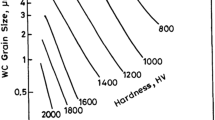Abstract
Forging processes are widely employed in the manufacture of consumer goods. The forging dies have machined cavities which usually are produced by high speed milling (HSM) with ball nose tools and, consequently, their final surfaces have a characteristic topography generated by the cutting conditions. The purpose of this study was to gain a better understanding of the correlation between the surface topography of a milled die and its wear during the hot forging process. To this end, dies were produced by milling process with four different types of topography, using distinct cutting conditions, and were tested by forging typical workpieces. The best tribological performance was achieved with the topography composed of micro cavities generated by high values of feed per tooth (f z) and radial depth of cut (a e) in the milling process, because it enabled the retention of a larger amount of lubricant, thus minimizing the adhesion of workpiece material on the die. Moreover, the use of high values of f z and a e reduced the production time of a die. Low values of f z and a e produced the opposite results, i.e., the worst tribological performance and the longest production time, indicating that their use should be avoided.
Similar content being viewed by others
References
Bayramoglu M, Polat H, Geren N (2008) Cost and performance evaluation of different surface treated dies for hot forging process. J Mater Process Technol 205:394–403
Turk R, Perus I, Terčelj M (2004) New starting points for the prediction of tool wear in hot forging. Int J Mach Tools Manuf 44:1319–1331
Kim DH, Lee HC, Kim BM, Kim KH (2004) Estimation of die service life against plastic deformation and wear during hot forging processes. J Mater Process Technol 166:372–380
Sjöström J, Bergström J (2005) Thermal fatigue in hot-working tools. Scand J Metall 34:221–231
Saiki H, Marumo Y, Minami A, Sonoi T (2001) Effect of the surface structure on the resistance to plastic deformation of a hot forging tool. J Mater Process Technol 113:22–27
Bowden FP, Tabor D (1953) The Friction and Lubrication of Solids. Clarendon
Altan T (1988) Hammers and presses for forging. In: Metals Handbook. 9 ed. v.14 - Forming and Forging. ASM International, pp. 25–71.
Rginey DA (1981) Fundamentals of friction and wear of materials. Am. Soc. Metals
Kim TH, Kim BM, Choi JC (1997) Prediction of die abrasive wear in the wire drawing process. J Mater Process Technol 65:11–17
Kim DH, Kim BM, Kang CG (2005) Estimation of die service life for a die cooling method in a hot forging process. Int J of Adv Manuf Technol 27(1–2):33–39
Lakshmipathy R, Sagar R (1992) Effect of die surface topography on die working interfacial friction in open die forging. Int J Mach Tools Manuf 32:685–692
Menezes PL, Kumar K, Kishore R, Kailas SV (2009) Influence of friction during forming processes—a study using a numerical simulation technique. Int J of Adv Manuf Technol 40:1067–1076
Menezes PL, Kishore R, Kailas SV, Lovell MR (2010) Response of materials as a function of grinding angle on friction and transfer layer formation. Int J of Adv Manuf Technol 49:485–495
Malayappan S, Narayanasamy R (2004) An experimental analysis of upset forging of aluminium cylindrical billets considering the dissimilar frictional conditions at flat die surfaces. Int J of Adv Manuf Technol 23(9–10):636–643
Wagner K, Völkl R, Engel U (2008) Tool life enhancement in cold forging by locally optimized surfaces. J Mater Process Technol 201(1–3):2–8
Schubert A, Neugebauer R, Sylla D, Avila M, Hackert M (2011) Manufacturing of surface microstructures for improved tribological efficiency of powertrain components and forming tools. CIRP J Manuf Sci Technol 4(2):200–207
Santos AV, Bezerra AA, Machado AR et al (2003) Usinagem em Altíssimas Velocidades: Como os conceitos HSM/HSC podem revolucionar a indústria metal mecânica. Editora Érica, São Paulo
Sandvik (2002) Fabricação de Moldes e Matrizes com a Sandvik Coromant. Catálogo
Dewes RC, Aspinwall DK (1997) A review of ultra high speed milling of hardened steels. J Mater Process Technol 69–1(3):1–17
Becker M, Santos SC, Sales WF (2005) Tecnologias Avançadas de Manufatura: Integridade Superficial em Usinagem. Novos Talentos, Jaboticabal (Brazil)
Stephenson DA, Agapiou JS (1997), Surface Finishing. In: ___________. Metal cutting theory and practice. Marcel Dekker, New York, pp. 651–655.
Schey JA (1983) Tribology in metalworking: friction. Lubrication and Wear, American Society for Metals, Ontario, 736 p
Jung T, Yang M, Lee K (2005) A new approach to analyzing machined surfaces by ball end milling. Part I: formulation of characteristic lines of cut remainder. Int J of Adv Manuf Technol 25:833–840
Handbook ASM (2005) Metalworking: bulk forming, 14A: 50–51. ASM, Metals Park, USA
Cohen DK (2009) Glossary of surface texture parameters. Michigan Metrology, Michigan
Author information
Authors and Affiliations
Corresponding author
Rights and permissions
About this article
Cite this article
Magri, M.L., Diniz, A.E. & Button, S.T. Influence of surface topography on the wear of hot forging dies. Int J Adv Manuf Technol 65, 459–471 (2013). https://doi.org/10.1007/s00170-012-4185-1
Received:
Accepted:
Published:
Issue Date:
DOI: https://doi.org/10.1007/s00170-012-4185-1




